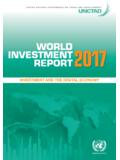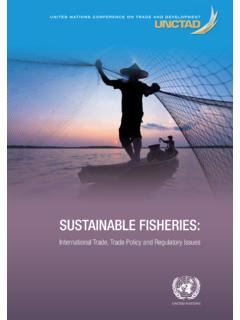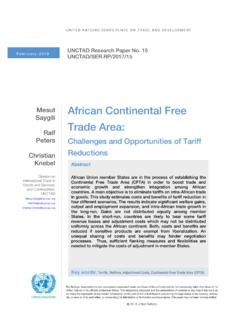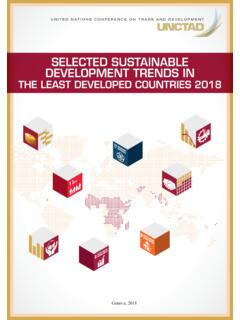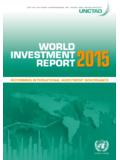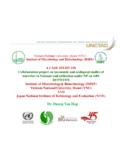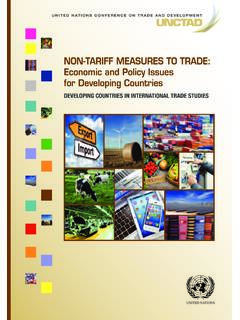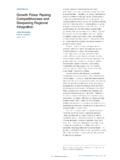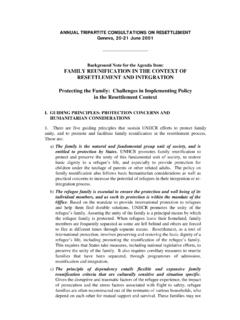Transcription of Regional trade agreements, integration and …
1 UNCTAD Research Paper No. 1. JULY 2017. Alisa DiCaprio Regional trade (Asian Development Bank Institute), agreements, integration Amelia U. Santos- and development Paulino (UNCTAD). and Maria V. Abstract Sokolova Developing countries have become more active participants in (UNCTAD and Graduate Regional trade agreements, which raise questions about how the Institute Geneva) benefits of integration are distributed. A key concern is whether countries at the low end of the income spectrum are able to capture development gains from integration . Historically, such impacts have been difficult to identify with precision. This paper contributes to the understanding of such issues by analysing the impact of Regional integration on growth and within country inequality. The investigation develops two measures of Regional integration using trade agreement participation as a proxy for preferential trade access. The analysis shows that Regional integration leads to higher economic growth and lower within-country inequality in member countries.
2 The direct development effects can be further enhanced by a second transmission channel whereby a country captures indirect benefits from any agreements to which its trading partners are party. The ability to capture gains from integration varies across developing country Regional groups with developing Asia benefiting on par with the developed world. Key words: Free trade agreements, Regional integration , panel data, low-income countries, least developed countries 2 UNCTAD Research Paper _____. Contents Acknowledgements .. 2. 1. Introduction .. 3. 2. Channels linking trade integration and development .. 5. Impacts and channels of Regional trade agreements on trade .. 5. Estimating the effect of Regional integration on development .. 7. Data definition and sources .. 8. 3. Empirical results .. 8. Internal and external exposure to regionalization .. 8. Econometric results .. 10. Further discussion .. 14. 4. Conclusion.
3 17. Annex 18. References .. 23. Acknowledgements The authors are grateful to seminar participants in the Asian Development Bank Institute, Tokyo, in July 2016, and Shanghai Forum 2017, China, for useful comments and suggestions on a previous version of the paper. Patrick Osakwe and an anonymous referee also reviewed and provided comments on the paper. Any remaining errors are the authors'. _____. 3 UNCTAD Research Paper _____. 1. Introduction Regional trade agreements (RTAs) can be a useful tool in promoting growth. 1 RTAs structure trade in a way that can increase domestic productive capacity, promote upward harmonization of standards, improve institutions, introduce technical know-how into the domestic market and increase preferential access to desirable markets. These are outcomes that could benefit developing economies in general and particularly the least developed countries (LDCs) and other low-income countries.
4 However, most studies of Regional integration agreements show that, on average, low-income countries benefit less (see for example Ariyasajjakorn et al., 2009; Feenstra, 1996). Despite the relatively low benefits for LDCs, every country in the LDC category is a member of at least one RTA. The agreements range from partial scope agreements to economic integration agreements targeting political union. Most RTAs involving LDCs are South South agreements (figure 1), which are generally poorly implemented and not known to be particularly beneficial for the industrialization of partner countries. There is also an increasing, albeit small, number of agreements in which LDCs are part of North South agreements (for example the European Union-Caribbean Forum (CARIFORUM) Economic Partnership Agreement). The expected impact of LDC participation in North South agreements is larger, but few studies have sought to quantify the impact.
5 Figure 1. Regional trade agreements by trading partner type (1990-2015). Source: Authors' calculations based on IMF data and Bergstrand (2015). Note: SS represents South South; SN, South North; and NN, North North RTA relationships. The paper's motivation is rooted in the Sustainable Development Goals. The Goals clearly recognize the role of trade as a potential development tool. In particular, they highlight the role inequality plays in holding States 1. Regional trade agreements are defined as any agreement involving tariffs lower than most-favoured nation rates. _____. 4 UNCTAD Research Paper _____. back (Goal 10 concerns reduced inequalities) and the potential role trade can play in addressing this (Goal 2. targets zero hunger and Goal 8 targets decent work and growth). In 2016, RTAs were the de facto way to access the global trade regime. As a result, a clear understanding of whether RTAs promote developmental outcomes such as reducing inequality is paramount.
6 This paper explores the question of how trade agreements affect inequality using two levels of analysis. The first is at the national level. A sovereign State can join an existing RTA or create a new one with its trading partners. The introduction of new trade relationships will affect between-household inequality in member States mostly through the impacts on the labour markets and wage earnings, akin to the general links between trade and poverty, although the direction is unclear. The second level is Regional . Not all neighbouring States have RTA relationships. Yet where an RTA exists, even non-member States are impacted by changes in trade flows. That is, there are potential impacts for a country that is not in a formal RTA but trades extensively with countries that are highly exposed to Regional agreement with other countries. This feature is incorporated into the analysis by estimating the effects of RTAs enacted by trading partners of a country with third parties.
7 To differentiate this from the direct benefits of being a party to an RTA, this indirect measure is referred to as external exposure to regionalization. The literature on the impact of RTAs on non-member countries has focused largely on trade outcomes (see for example Winters and Chang, 2002) and growth rates (Hur and Park, 2012). trade , on average, improves a country's growth and such an impact is expected to be higher in less developed countries. However, trade has multidirectional impacts on inequality and development. This level is particularly critical for LDCs, which would have the most to gain if RTAs narrowed Regional gaps in inequality. Yet, while LDCs often receive the most preferential treatment, their vulnerability to shocks makes the benefits from openness (both direct and indirect) less evident. While RTAs can lead to convergence, some show that the poor countries in a region are more likely to diverge (see for example Venables, 1999).
8 This paper attempts to capture both growth and development effects by considering whether lower levels of within-country inequality can be attributed to RTAs, controlling for the impact on low-income countries and other Regional groups. Two new measures of Regional integration are introduced. The first measure is based on bilateral trade between RTA members and captures the ability of a country to have a self-determined Regional trade policy. The second relates to the situation when a country is engaged in the Regional networks of other countries. The results show that both a country's own regionalization and its exposure to the regionalization of others positively contribute to economic growth globally. However, the results vary according to developing country clusters, with some areas such as sub-Saharan Africa having experienced relatively lower growth as a result of internal regionalization and exposure to regionalization.
9 In addition, growth results in positive distributional outcomes in the developing country clusters that are involved in more regionalization, compared with the rest of the world. For example, in developing Asia, a 10. per cent increase in internal regionalization resulted in a nearly 3 per cent reduction in income inequality. This suggests that location in a region that is characterized by noodle bowl Regional trade policy activities observes a lesser increase in inequality. 2 The paper also addresses the impact of various types of regionalization on inequality through its impact on gender. Liberalization increases trade by lowering the tariffs that distort markets. Going one step further, trade has been shown to increase growth (see for example Frankel and Romer, 1999). However, the evidence about how openness impacts development-relevant indicators is less conclusive. This has been recognized at the multilateral level, and policymakers have introduced policy guidelines aimed at making trade more inclusive for all participants.
10 One of the most prominent examples is the European Commission's Sustainability Impact Assessment that was first developed for the World trade Organization (WTO) Doha Development Agenda 2. Baldwins (2006), referred to the well-known puzzle of overlapping RTAs described by Bhagwati (1991) as spaghetti bowl','noodle bowl', to describe the proliferation of trade agreements in Asia. _____. 5 UNCTAD Research Paper _____. negotiations. It promotes corporate social responsibility, which has been shown to translate into more socially sustainable trade (Vidal-Leon, 2013). The literature shows a number of transmission channels for welfare gains from trade . The lessons from the trade literature are great, especially the contribution of various elements to changes in income. However, Arokolakis, Costinot and Rodriguez-Clare (2013) suggest that the welfare gains from trade may vary by input, that is, imports of intermediate inputs and supply networks, yet overall can be estimated by looking at standard trade statistics.
